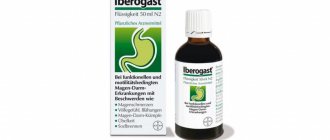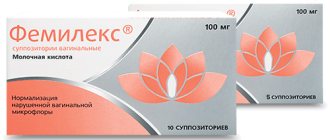Pharmacodynamics and pharmacokinetics
Taking this medication allows you to compensate for the insufficiency of external secretory function in the pancreas. At the same time, it has a proteolytic, amylolytic and lipolytic effect.
The enzymes that make up Pancreatin , namely lipase, alpha-amylase, chymotrypsin and trypsin , help break down proteins into amino acids, fats into fatty acids and glycerol, starch into monosaccharides and dextrins. The functional state of the gastrointestinal tract also improves, and digestive processes are normalized.
Thanks to trypsin, stimulated pancreatic secretion is inhibited, producing an analgesic effect.
In the alkaline environment in the small intestine, pancreatic enzymes are released from the dosage form because they are protected from the influence of gastric juice in the form of a shell.
The manifestation of maximum enzymatic activity occurs 30-45 minutes after oral administration. Pancreatin is not absorbed into the gastrointestinal tract; the substance is excreted along with the feces.
Instructions for medical use of the drug Penzital Gastro
Excipients: lactose, microcrystalline cellulose, sodium starch glycolate, povidone, talc, colloidal silicon dioxide, methacrylic acid copolymer, diethyl phthalate, titanium dioxide.
Description
White, round, biconvex film-coated tablets. Pharmacotherapeutic group: digestive enzyme agent
ATX code: A09AA02
Pharmacological properties
Compensates for insufficiency of exocrine pancreatic function and has proteolytic, amylolytic and lipolytic effects. The enzymes included in pancreatin (lipase, alpha-amylase, trypsin, chymotrypsin) promote the breakdown of proteins into amino acids, fats into glycerol and fatty acids, starch into dextrins and monosaccharides.
Improves the functional state of the gastrointestinal tract, normalizes digestion processes. Trypsin inhibits stimulated pancreatic secretion, producing an analgesic effect.
Pancreatic enzymes are released from the dosage form in the alkaline environment of the small intestine, since they are protected from the action of gastric juice by the membrane. Maximum enzymatic activity is observed 30-45 minutes after oral administration.
Indications for use
Replacement therapy for exocrine pancreatic insufficiency: chronic pancreatitis, pancreatectomy, condition after irradiation, dyspepsia, Roemheld syndrome (gastrocardiac syndrome), cystic fibrosis; flatulence, diarrhea of non-infectious origin.
Impaired digestion of food (condition after resection of the stomach and small intestine); to improve food digestion in persons with normal gastrointestinal function in case of errors in nutrition (eating fatty foods, large amounts of food, irregular meals) and in cases of chewing dysfunction, sedentary lifestyle, prolonged immobilization.
Preparation for X-ray examination and ultrasound of the abdominal organs.
Contraindications
Hypersensitivity to the components of the drug, acute pancreatitis, exacerbation of chronic pancreatitis.
Directions for use and doses
For oral administration. 1-2 tablets before meals, without chewing and with water (water, fruit juices). If necessary, take an additional 2-4 tablets with meals. In cases where higher doses of pancreatin are required, a doctor's consultation is necessary to prescribe a higher dosage depending on the symptoms (for example, reducing the severity of steatorrhea, abdominal pain).
The dose is determined individually depending on the degree of digestive disturbance. Adults usually take 1 - 2 tablets 3 times a day.
In children, the drug is used as prescribed by a doctor.
The duration of treatment can vary from several days (if the digestive process is disrupted due to errors in the diet) to several months or years (if constant replacement therapy is necessary).
Side effect
Allergic reactions. In some cases - diarrhea, constipation, discomfort in the stomach, nausea (the cause-and-effect relationship of the development of these reactions with the action of pancreatin has not been established, since these phenomena refer to symptoms of exocrine pancreatic insufficiency). With long-term use in high doses, the development of hyperuricosuria and an increase in the level of uric acid in the blood plasma is possible. In cystic fibrosis, if the required dose of pancreatin is exceeded, strictures (fibrous colonopathy) may develop in the ileocecal region of the ascending colon.
When using pancreatin in high doses in children, perianal irritation and irritation of the oral mucosa may occur.
Overdose
Symptoms: hyperuricosuria, hyperuricemia. Children are constipated.
Treatment: drug withdrawal, symptomatic therapy.
Interaction with other drugs
With the simultaneous use of pancreatin with iron preparations, the absorption of the latter may be reduced. Concomitant use of antacids containing calcium carbonate and/or magnesium hydroxide may lead to a decrease in the effectiveness of pancreatin.
special instructions
The safety of using pancreatin during pregnancy has not been sufficiently studied. Use is possible in cases where the expected benefit to the mother outweighs the potential risk to the fetus. In cystic fibrosis, the use of pancreatin in high doses is not recommended due to the increased risk of developing strictures (fibrotic colonopathy). The dose should be adequate to the amount of enzymes necessary for the absorption of fats, taking into account the quality and quantity of food consumed.
With long-term use, iron supplements are prescribed simultaneously.
Release form
10 enteric-coated tablets in strips. 1, 2, 3, 4, 5, 6, 7, 8, 9, 10, 11, 12 strips in a cardboard box along with instructions for use.
Storage conditions
At temperatures from +2° to +25°C, in a dry place, out of reach of children.
Best before date
3 years. Do not use after the expiration date stated on the package.
Conditions for dispensing from pharmacies
Over the counter.
Manufacturer
Shreya Life Sciences Pvt. Ltd., India
Send consumer claims to the representative office address: 111033 Moscow, st. Zolotorozhsky Val, 11, building 21 tel.
Indications for use of Penzital
Main indications for use:
- carrying out replacement treatment for exocrine insufficiency in the pancreas, for example, in chronic pancreatitis, pancreatectomy , post -dyspepsia , radiation , Roemheld syndrome or gastrocardial syndrome, cystic fibrosis ;
- diarrhea of non-infectious origin, flatulence ;
- impaired absorption of food, for example, after resection of the small intestine and stomach;
- the need to improve the digestion of food in people with normal gastrointestinal function with errors in nutrition - large amounts of food, fatty foods, irregular meals, as well as chewing dysfunction, a sedentary lifestyle and prolonged immobilization;
- preparation for x-ray examination or ultrasound of internal organs.
Penzital
Penzital
(English:
Penzital
) is an Indian enzyme medicine intended to normalize digestion. Penzital compensates for pancreatic insufficiency. Enzymes included in Penzital such as lipase, amylase and protease promote the breakdown and better absorption of carbohydrates, fats and proteins in the small intestine.
Dosage form and composition of Penzital
Penzital is available in the form of enteric-coated tablets. The active substance of Penzital - pancreatin, 212.5 mg, is located in the core of the tablet and provides minimal activity:
- lipolytic - 6000 FIP units
- amylolytic - 4500 FIP units
- total proteolytic - 300 FIP units
Excipients: lactose, titanium dioxide, diethyl phthalate, colloidal silicon dioxide, sodium starch glycolate, povidone, talc, methacrylic acid copolymer, microcrystalline cellulose.
Indications for use of Penzital
Penzital is indicated for the following diseases and conditions:
- chronic pancreatitis
- cystic fibrosis
- insufficiency of exocrine pancreatic function
- chronic inflammatory-dystrophic diseases of the stomach, intestines, liver, gall bladder
- conditions after surgical operations on the digestive organs or their irradiation, accompanied by impaired digestion of food, flatulence, diarrhea (as part of combination therapy)
- to improve food digestion in patients with a normal state of the digestive system organs with errors in nutrition, disorders of chewing function
- with a sedentary lifestyle, including prolonged immobilization for medical or other reasons
- in preparation for ultrasound or x-ray examination of the abdominal organs
Contraindications to the use of Penzital
Penzital is contraindicated for:
- acute pancreatitis
- exacerbation of chronic pancreatitis in the acute stage
- hypersensitivity to the components of Penzital
Use of Penzital by pregnant and nursing mothers
The FDA risk category for the fetus when using Pancreatin (the active ingredient in Penzital) is “C” (animal studies have shown a negative effect of the drug on the fetus, and there have been no adequate studies in pregnant women, but the potential benefits associated with the use of this drug in pregnant women are may justify its use, despite the risk.There is
no information on whether pancreatin (the active substance of Penzital) passes into breast milk during breastfeeding.Therefore, therapy with pancreatin in nursing mothers is not advisable.
How to take Penzital and dosage
Penzital is taken orally during or after meals, the tablets are not chewed and washed down with a non-alkaline liquid: water or fruit juices. The duration of treatment - from several days to several months or even years - is determined by the doctor, as well as the dose (especially for children). The dose is determined individually depending on the degree of digestive disturbance. For adults, Penzital usually prescribes 1-2 tablets 3 times a day.
Interaction of Penzital with other drugs
When taken simultaneously with antacids containing magnesium hydroxide or calcium carbonate, the pharmacological effect of Penzital may be reduced.
When taken simultaneously with iron-containing drugs, the effectiveness of the latter may decrease.
general information
According to the pharmacological index, Penzital belongs to the group “Enzymes and antienzymes”.
According to ATC, it belongs to the group “A09 Drugs that promote digestion (including enzyme preparations)” and has the code “A09AA02 Pancreatin”. Manufacturer: Shreya Life Sciences Pvt. Ltd. (Shreya Life Sciences), India.
On the website gastroscan.ru in the literature catalog there is a section “Enzyme preparations”, containing articles on the use of enzyme preparations in the treatment of diseases of the gastrointestinal tract.
Other medications in which pancreatin is the main active ingredient
Medicines in which pancreatin is the only active ingredient are registered in Russia (were previously registered): Vestal, Gastenorm forte, Gastenorm forte 10000, Creon, Creon 10000, Creon 25000, Creon 40000, Mezim 20000, Mezim forte, Mezim forte 10000, Mikrazim , Pangrol 10000, Pangrol 25000, PanziKam, Panzim forte, Panzinorm forte-N, Panzinorm 10,000, Panzinorm forte 20,000, Pancreazym, Pancrealipase 8000, Pancreatal Kirschner, Pancreatin-concentrate, Pancreatin-LekT, Pancreatin, Pancreatin tablets (solution found in the intestines ), Pankrelipase, Pankrenorm, Pancitrate, Festal N, Uni-Festal, Enzistal-P, Ermital.
Penzital has contraindications, side effects and application features; consultation with a doctor is necessary.
Back to section
Penzital - instructions for use (Method and dosage)
The tablets are intended for oral and are best taken before meals . In this case, ordinary water is suitable for drinking. It is contraindicated to use alkaline liquids for this purpose.
According to the instructions for use of Penzital, dose selection is carried out by a gastroenterologist, who must take into account the patient’s diet and the degree of enzyme deficiency. The average daily dosage for adult patients is: 1-2 tablets 3 times . It is allowed to increase the daily dosage to 16 tablets.
When treating small patients, dose selection is performed individually.
The course of therapy is determined by the attending physician and can last for several years.
Interaction
The simultaneous use of Penzital and antacid drugs with aluminum, calcium or magnesium ions can significantly reduce its effect. Iron supplements can reduce iron absorption.
Combination therapy with this drug with antithrombic drugs and acetylsalicylic acid reduces their effectiveness.
When treatment is prescribed simultaneously with non-selective monoamine reuptake inhibitors, the development of dangerous lethargy can be expected; with M-anticholinergic blockers, an increase in anticholinergic effect is noted, and alkaline liquids disrupt the pharmacodynamics of Penzital.
Analogs
Level 4 ATC code matches:
Digestin
Creon
Pancitrate
Mezim
Festal
Pankreoflat
Pancreazim
Enterosan
Panzinorm Forte
Panzinorm
Micrasim
Enzistal P
Pancreatin
Pangrol
Hermital
Abomin
The main analogues of this drug are represented by such drugs as: Gastenorm Forte, Creon, Mezim, Micrazim, Pangrol 10000, PanziKam, Panzinorm, Panzim Forte and others.
Also drugs with a similar effect are: Pancrelipase, Pancitrate Festal, Enzistal-P, Ermital and so on.
Reviews about Penzital
This drug is especially popular not only among patients suffering from various gastrointestinal diseases, but also in need of a cure for overeating. Therefore, reviews of Penzital are found everywhere. This drug is often prescribed during pregnancy , since during this period its quickly effective effect, which practically does not cause side effects, may be required. For example, it is actively used by women who feel severe heaviness in the stomach or nausea .
In addition, the drug can be prescribed to this group of patients to improve digestion and normalize the functions of the digestive tract. Although many ladies don’t even know exactly why Penzital helps during pregnancy. Therefore, you often find detailed explanations from specialists who tell you why Penzital tablets help best, how and when they should be taken.
In general, as reviews show, this drug is quite effective. However, despite the fact that it is enzymatic and, according to some, safe for the body, it is not recommended to take it without a doctor's prescription.
The use of enzyme preparations for digestive disorders in children
Digestion is a single, holistic process due to the close relationships between the activities of various parts of the digestive tract. Dysfunction of one part of the gastrointestinal tract, as a rule, leads to dysfunction of other organs. Different processes of absorption of nutrients occur in different parts of the digestive tract. In the stomach - protein breakdown, secretion of internal factor, oxidation of iron ions; in newborns - the breakdown of fats (formation of diglycerides under the action of gastric lipase). In the duodenum - entry of bile acids, emulsification of fat, breakdown of triglycerides, formation of mono- and diglycerides, breakdown of starch and disaccharides, breakdown of protein, absorption of monosaccharides, amino acids, iron, calcium, zinc, magnesium. In the jejunum - breakdown of disaccharides; absorption of monosaccharides, monoglycerides, bile acids, fat-soluble vitamins, folate, calcium, iron, magnesium, zinc, vitamin B12. In the ileum - absorption of bile salts, water, sodium, and the main amount of vitamin B12. In the large intestine - absorption of water, potassium, sodium, calcium, bile salts.
An important digestive organ in the body is the pancreas (PG), which performs an exocrine function. When food enters the gastrointestinal tract, the pancreas secretes into the small intestine not only pancreatic enzymes, but also bicarbonates, which neutralize hydrochloric acid and maintain an alkaline environment in the duodenum, necessary for the normal functioning of pancreatic enzymes. Under physiological conditions, the pancreas produces from 50 to 2500 ml of secretion per day, depending on the age of the person and the nature of the incoming food. Pancreatic juice is a colorless liquid with an alkaline reaction (pH 7.8–8.4). It contains organic substances (proteins) and inorganic components (bicarbonates, electrolytes, trace elements), as well as mucus of the excretory ducts. The enzymatic part of the secretion is formed in acinar cells, and the liquid (water-electrolyte) part - mucin and bicarbonates - by the ductal epithelium. With the help of pancreatic enzymes (lipase, amylase and proteases), which play a key role in the exocrine function of the pancreas, the breakdown of nutrients occurs. Most of them are in an inactive form - these are proenzymes that are activated in the duodenum by enterokinase. Lipase, amylase and ribonuclease are secreted in active form. This mechanism determines the activity of pancreatic juice in the intestinal cavity, which, in turn, protects pancreatic tissue from autolysis.
Digestive enzymes of the pancreas have their own targets: amylase - α-1,4-glycosidic bonds of starch, glycogen; lipase - triglycerides (formation of di-monoglycerides and fatty acids); phospholipase A - phosphatidylcholine (formation of lysophosphatidylcholine and fatty acids); carboxylesterase - cholesterol esters, esters of fat-soluble vitamins, tri-, di-, monoglycerides; trypsin - internal protein bonds (basic amino acids); chymotrypsin - internal protein bonds (aromatic amino acids, leucine, glutamine, methionine); elastase - internal bonds of proteins (neutral amino acids); carboxypeptidase A and B - external bonds of proteins, including aromatic and neutral aliphatic amino acids (A) and basic (B) amino acids from the carboxyl end.
The last four enzymes are secreted by the pancreas in an inactive form (proenzymes) and are activated in the duodenum.
Exocrine pancreatic dysfunction is observed in various hereditary and acquired diseases and may be caused by impaired formation of pancreatic enzymes or their activation in the small intestine. Due to pancreatic dysfunction, accompanied by enzyme deficiency, a disorder of food digestion (maldigestion) and absorption of nutrients (malabsorption) in the intestine develops.
Maldigestion in children is caused by a number of disorders.
- Decreased activity of pancreatic enzymes. It can be caused by chronic or acute pancreatitis, cystic fibrosis, congenital pathology of the pancreas - morphological anomalies of the pancreas (abberant pancreas, ring-shaped pancreas, stenosis of the papilla of Vater or sphincter of Oddi, cysts, bifurcated pancreas), hereditary syndromes accompanied by congenital pancreatic insufficiency (Shwachman syndrome). Diamond, pancreatic insufficiency syndrome with multiple anomalies, deafness and dwarfism (Iohanson-Bizzard), pancreatic insufficiency syndrome with vacuolation of bone marrow cells and sideroblastic anemia (Pearson); isolated enzymatic deficiency (lipase - Sheldon-Rey syndrome; amylase, trypsin, enterokinase) , as well as pancreatic trauma, pancreatic carcinoma, primary sclerosing cholangitis.
- Bile acid deficiency in the small intestine associated with functional disorders of the biliary tract, hepatitis, liver cirrhosis, biliary obstruction.
- Violation of cholecystokinin synthesis caused by damage to the duodenal bulb (chronic duodenitis, chronic gastroduodenitis).
- Inactivation of pancreatic enzymes in the small intestine as a result of intestinal dysbiosis or rapid passage of food.
- Impaired mixing of enzymes with food chyme associated with gastro- and duodenostasis.
The cause of malabsorption is a violation of the activity of the secretion of intestinal enzymes, caused by disaccharidase deficiency, a gastrointestinal form of food allergy, a violation of intracellular digestion (celiac disease, Crohn's disease, enteritis, etc.), a violation of the transport of absorbed substances (exudative enteropathy, lymphoma, tumors, tuberculosis).
It is known that the pancreas has great compensatory capabilities, and disorders of pancreatic secretion appear only in cases of severe damage to the gland. There is an opinion that severe steatorrhea and creatorrhea in adults develop in cases where the secretion of pancreatic lipase and trypsin decreases by more than 90%. However, such a threshold has not been established in children.
The causes and mechanisms of development of exocrine pancreatic insufficiency are varied. There are absolute pancreatic insufficiency, caused by a decrease in the volume of functioning pancreatic parenchyma, and relative, which can be associated with various diseases of the gastrointestinal tract.
If symptoms indicating exocrine pancreatic insufficiency are identified, it is necessary to begin replacement therapy with pancreatic enzymes as early as possible, before malabsorption begins to develop.
Clinical signs of exocrine pancreatic insufficiency are:
- stomach ache,
- loss of appetite,
- flatulence,
- unstable chair,
- steatorrhea,
- nausea,
- recurrent vomiting,
- general weakness,
- weight loss,
- decreased physical activity,
- growth retardation (in severe forms).
There are quite a large number of methods for assessing the digestive capacity of the gastrointestinal tract.
- Determination of the content of pancreatic enzymes in the blood and urine. In acute pancreatitis, the level of amylase in the blood and urine can increase 5-10 times; the level of amylase and lipase in the blood during exacerbation of chronic pancreatitis can be normal or increase for a short time by 1-2 times (from several hours to several days), determination of elastase-1 in the blood plasma, the level of its increase reflects the severity of pancreatitis. The development of hyperenzymemia depends on the period and severity of pancreatitis.
- Scatological research. It should be recognized that scatological research has not lost its relevance to this day and is the most accessible method. It should be carried out before prescribing pancreatic enzymes to the patient. However, the accuracy of this method is also influenced by the state of intestinal motility, the volume of bile secreted into the intestinal lumen, its qualitative composition, the presence of inflammatory processes in the intestine, etc.
In case of digestive disorders, the following symptoms are identified: steatorrhea - the presence of neutral fat in the stool (type 1 steatorrhea); fatty acids, soap (type 2 steatorrhea); both (steatorrhea type 3); creativeorrhea - may be a sign of a violation of the exocrine function of the pancreas. Normally, there are very few muscle fibers in feces; amilorrhea - the presence of a large number of starch grains in the stool - indicates a violation of the breakdown of carbohydrates; It is rarely detected in patients with pancreatic insufficiency, since starch hydrolysis is practically not impaired due to the high activity of intestinal amylase. The earliest sign of exocrine pancreatic insufficiency is steatorrhea; creatorrhoea appears somewhat later. Amilorrhea is rarely observed in exocrine pancreatic insufficiency.
- Study of the content of pancreatic enzymes in duodenal secretions. The method allows you to determine the type of secretion: normosecretory, hypersecretory, hyposecretory or obstructive. The identified types of secretion reflect different degrees of functional and morphological changes in the pancreas, which allows differentiated treatment measures.
- Quantitative determination of fat in feces (stool lipid profile). This method makes it possible to summarize the total amount of fat in feces, taking into account fat of exogenous (food) origin. Normally, the amount of fat excreted in feces should not exceed 10% of the fat introduced with food. In diseases of the pancreas, the amount of fat excreted in feces sometimes increases to 60%. The method can be used to clarify the nature of steatorrhea and assess the effectiveness of enzyme therapy.
- Determination of elastase-1 content in feces. Elastase-1 is a proteolytic enzyme of the pancreas. It is known that human pancreatic elastase does not change its structure as it passes through the gastrointestinal tract. This method has certain advantages over those used today in the diagnosis of exocrine pancreatic insufficiency (fecal lipidogram, coprogram, determination of chymotrypsin in feces) due to the high specificity of the method (93%), its non-invasiveness and the lack of influence of enzyme preparations on the results of the elastase test.
Enzyme preparations were first used in gastroenterological practice about 100 years ago. Digestive enzymes are currently widely used for various gastroenterological pathologies. Despite the variety of manifestations of enzymatic digestive disorders, the main direction of treatment for such patients is enzyme replacement therapy. Currently, a large number of enzyme preparations are used in clinical practice, characterized by different combinations of components, enzyme activity, production method and release form. When choosing an enzyme preparation in each specific case, the doctor must first of all pay attention to its composition and the activity of its components.
There are two directions of action of enzyme preparations:
- primary - hydrolysis of food substrates, which is the basis for prescribing enzymes as replacement therapy for exocrine pancreatic insufficiency;
- secondary - reduction of abdominal pain syndrome (with pancreatitis), dyspepsia (feeling of heaviness, flatulence, belching, stool disorders, etc.).
Indications for prescribing enzyme therapy are:
- impaired secretion of pancreatic enzymes;
- maldigestion and malabsorption syndrome;
- motility disorders of the gastrointestinal tract.
Classification of enzyme preparations
The following groups of enzyme preparations are distinguished.
- Preparations containing pancreatin (pancreatin, penzital, mezim forte, panzinorm forte - N, creon, pancitrate).
- Preparations containing pancreatin, bile components, hemicellulase and other components (festal, digestal, enzistal, panzinorm forte).
- Herbal preparations containing papain, rice fungus extract and other components (pepphys, oraza).
- Combined enzymes containing pancreatin in combination with plant enzymes, vitamins (wobenzym, phlogenzyme).
Despite the fact that there are currently many pancreatic enzyme preparations in the doctor’s arsenal, it is still not always possible to select adequate enzyme replacement therapy in patients with severe forms of pancreatic insufficiency. The instability of many enzymes in an acidic environment remains a serious problem.
Products containing pancreatin include lipase, amylase, proteases. The raw material for the preparation of these drugs is the pancreas of pigs and cattle. When choosing enzyme preparations, it is necessary to take into account the level of enzymes included in their composition (Table 1).
Preparations containing pancreatic enzymes can be used either continuously, as replacement therapy, or once, with a high food load. The dose is selected individually and depends on the severity of clinical and laboratory parameters of exocrine pancreatic function. The effectiveness of the dose is judged by clinical (disappearance of abdominal pain, normalization of stool frequency and character) and laboratory indicators (disappearance of steatorrhea and creatorrhoea in the coprogram, normalization of triglycerides in the stool lipidogram).
Enzyme-containing preparations, along with pancreatin, may contain bile acids, hemicellulase, plant choleretic components (turmeric), simethicone, etc. (Table 2). The main indication for the use of drugs in this group in children is dysfunction of the biliary tract (hypomotor dyskinesia). Bile acids and salts increase the contractile function of the gallbladder, normalize the biochemical properties of bile, and also regulate the motility of the large intestine in children with constipation. They should be used during or immediately after meals (without chewing) 3-4 times a day in courses of up to 2 months. Enzymes of this group are not used for pancreatitis, as they contain bile components that enhance intestinal motility.
Bile acids included in the preparations increase pancreatic secretion and choleresis; stimulate intestinal and gallbladder motility.
Under conditions of microbial contamination of the intestine, deconjugation of bile acids occurs, and cyclic adenosine monophosphate of enterocytes is activated with the development of osmotic and secretory diarrhea. Bile acids enter the enteropathic circulation and are metabolized in the liver, increasing the load on it. In addition, bile acids can have a direct damaging effect on the intestinal mucosa.
Hemicellulase ensures the breakdown of polysaccharides of plant origin (digestible fiber) and reduces gas formation.
Contraindications to the use of enzyme preparations containing bile components:
- acute pancreatitis;
- chronic pancreatitis;
- acute and chronic hepatitis;
- diarrhea;
- peptic ulcer of the stomach and duodenum;
- inflammatory bowel diseases.
Enzyme preparations of plant origin containing papain, rice fungus extract and other components can be used to correct exocrine pancreatic insufficiency. They are made from plant materials.
The group of enzyme preparations of plant origin includes:
- Nigedase - plant lipase (Nigella damascene) - 20 mg; the drug, due to the absence of proteo- and amylolytic enzymes in its composition, is prescribed in combination with pancreatin;
- orase - a complex of amylolytic and proteolytic enzymes of fungal origin - Aspergillus oryzae (lipase, amylase, maltase, protease);
- pepphys - fungal diastase - 20 mg, papain - 60 mg, simethicone - 25 mg;
- solizym - lipase produced by the fungus Penicillum solution (20,000 units);
- somilase—solizim and fungal L-amylase;
- unienzyme - fungal diastase - 20 mg, papain - 30 mg, simethicone - 50 mg, activated carbon - 75 mg, nicotinamide - 25 mg;
- Wobenzym - pancreatin - 100 mg, papain - 60 mg, bromelain - 45 mg, trypsin - 24 mg, chymotrypsin - 1 mg, rutoside - 50 mg;
- merkenzyme - pancreatin - 400 mg, bromelain - 75 units, bile - 30 mg;
- phlogenzyme - bromelain - 90 mg; trypsin - 48 mg, rutoside - 100 mg.
The preparations pepphys, unienzyme, wobenzym, merkenzyme and phlogenzyme contain bromelain - a concentrated mixture of proteolytic enzymes from the extract of fresh pineapple fruits and its branches. The effectiveness of bromelains does not depend on the amount of hydrochloric acid in the stomach (pH 3-8.0).
All of the listed enzyme preparations of plant origin are contraindicated in patients with fungal and household sensitization, and with bronchial asthma (A. A. Korsunsky, 2000). Solizim and somilase should not be prescribed if you are allergic to penicillin antibiotics.
Enzymes based on plant materials can be used to correct exocrine pancreatic insufficiency, especially in cases where the patient cannot tolerate pancreatic enzymes (allergy to pork, beef).
It should be noted that data have appeared in the literature indicating the low enzymatic activity of enzymes of plant and fungal origin (75 times less effective than drugs of animal origin), and therefore they have not found widespread use in pediatric practice.
Simple enzymes (betaine, abomin) do not belong to the group of pancreatic enzymes. The following drugs with proteolytic activity are currently registered:
- abomin (combined preparation from the gastric mucosa of calves and lambs);
- acidin - pepsin (the tablet contains 1 part pepsin and 4 parts betaine hydrochloride; when it enters the stomach, betaine hydrochloride is hydrolyzed and hydrochloric acid is released);
- pepsidil (contains pepsin and peptones);
- pepsin (a proteolytic enzyme obtained from the mucous membrane of pigs and lambs).
These drugs are obtained from the gastric mucosa of pigs, calves or lambs. The presence of pepsin, cathepsin, peptidases, and amino acids in the preparations promotes the release of gastrin, which is a regulatory polypeptide, and therefore drugs of this group can be prescribed for functional disorders of the gastrointestinal tract, for gastritis with secretory insufficiency, which is relatively rare in older children. These drugs are prescribed orally with meals.
These drugs should not be prescribed for exocrine pancreatic insufficiency.
The success of therapy for exocrine pancreatic insufficiency depends on many reasons. Recent studies have not found significant differences in effectiveness when taking enzyme preparations hourly and using them with meals. However, the most convenient and physiological for the patient is to take enzyme preparations with meals.
In the case of an adequately selected dose and form of the enzyme preparation, a significant improvement in the patient’s condition occurs. The criteria for the effectiveness of treatment are the disappearance of polyfecal matter, reduction or elimination of diarrhea, increase in body weight, disappearance of steatorrhea, amilorrhea and creatorrhoea. Creatorrhoea is usually the first to disappear during enzyme therapy. This may be due to the fact that the secretion of pancreatic protease persists slightly longer than lipase.
The dose of the enzyme preparation is selected individually during the first week of treatment, depending on the severity of exocrine pancreatic insufficiency. It is advisable to calculate the dose of the enzyme preparation based on lipase, starting with small dosages (1000 IU of lipase per kg of body weight per day). If there is no effect, the dose of the drug is gradually increased under the control of scatological studies. For severe exocrine insufficiency, 4000–5000 IU of lipase per kg of body weight per day is used in 3–4 doses. The duration of therapy is determined individually. Enzyme intake is stopped if clinical and scatological signs of maldigestion and malabsorption disappear.
Reasons for lack of effect with enzyme therapy:
- insufficient dose of the drug;
- loss of enzyme activity in the drug due to violation of shelf life;
- inactivation of the enzyme in the stomach;
- destruction of enzymes during intestinal dysbiosis with high colonization of the stomach and duodenum;
- inactivation of enzyme preparations due to high “acidification” of the duodenum (to prevent this phenomenon, antacids and H2-histamine receptor blockers are prescribed);
- incorrect diagnosis (type 2 steatorrhea; giardiasis, etc.);
- violation of the drug regimen.
Despite the fact that with the help of enzyme preparations the degree of steatorrhea can be significantly reduced, its complete and permanent disappearance cannot always be achieved.
Factors that prevent the disappearance of steatorrhea:
- malabsorption syndrome;
- low micellar concentration of bile acids due to the fact that they are deposited in the pathologically acidic contents of the duodenum;
- non-simultaneous release of enzymes from the stomach with food (microtablets or microspheres with a diameter of no more than 2.0 mm are transported from the stomach faster than tablets or dragees of large diameter);
- sensitivity of lipase to the acidic contents of the stomach (up to 92% of the lipase included in “ordinary” enzymes is easily destroyed by hydrochloric acid).
Ways to overcome enzyme inactivation by gastric juice:
- increasing the dose of the drug;
- prescribing antacids (it must be remembered that antacids containing calcium or magnesium weaken the action of enzymes);
- prescription of H2-blockers of histamine receptors.
Contraindications to the use of enzyme preparations:
- acute pancreatitis (first 7-10 days);
- exacerbation of chronic pancreatitis (during the first 3-5 days);
- allergy to pork and beef products.
Currently, thanks to a large selection of pancreatic enzyme preparations, there is a real possibility of individual correction of digestive disorders in children with exocrine pancreatic insufficiency, functional disorders of the stomach, and biliary tract. Prescribing enzyme preparations requires a differentiated approach from the doctor in each specific case - it is necessary to take into account the mechanisms of development of the disease that led to disruption of the digestive processes.
N. A. Korovina , Doctor of Medical Sciences, Professor I. N. Zakharova , Doctor of Medical Sciences, Professor of RMAPO, Moscow
Penzital price, where to buy
This drug in enteric-coated tablets can be purchased at any Russian pharmacy. At the same time, the price of Penzital for 20 pieces can vary between 51-60 rubles.
- Online pharmacies in RussiaRussia
ZdravCity
- Penzital Gastro tab.
By. intestinal solution 212.50 mg 20 pcs Shreya Life Sciences Pvt.Ltd 59 RUR order - Penzital Gastro tab. p/o col.sol. 212.50 mg 80 pcs Shreya Life Sciences Pvt, Ltd
RUB 183 order
Penzital film-coated tablets 80 pcs. in Krasnodar
Latin name
PENZITAL
International nonproprietary name
Pancreatin
Release form
Enteric-coated tablets
Package
10 pieces. — strips (8) — cardboard boxes
Description
White, round, biconvex.
pharmachologic effect
Enzyme agent. Contains pancreatic enzymes - amylase, lipase and proteases, which facilitate the digestion of carbohydrates, fats and proteins, which facilitates their more complete absorption in the small intestine. In diseases of the pancreas, it compensates for the insufficiency of its exocrine function and helps improve the digestion process.
Indications
Insufficiency of exocrine pancreatic function (including in chronic pancreatitis, cystic fibrosis).
Chronic inflammatory-dystrophic diseases of the stomach, intestines, liver, gall bladder; conditions after resection or irradiation of these organs, accompanied by impaired digestion of food, flatulence, diarrhea (as part of combination therapy).
To improve the digestion of food in patients with normal gastrointestinal function in case of errors in nutrition, as well as in cases of impaired chewing function, forced long-term immobilization, and a sedentary lifestyle.
Preparation for x-ray and ultrasound examination of the abdominal organs
Directions for use and doses
The dose (in terms of lipase) depends on age and the degree of pancreatic insufficiency. The average dose for adults is 150,000 units/day. In case of complete insufficiency of exocrine pancreatic function - 400,000 units/day, which corresponds to the daily requirement of an adult for lipase.
The maximum daily dose is 15,000 units/kg.
Children under 1.5 years old - 50,000 units/day; over 1.5 years - 100,000 units/day.
The duration of treatment can vary from several days (if the digestive process is disrupted due to errors in the diet) to several months and even years (if constant replacement therapy is necessary).
Compound
1 tab. - Pancreatin 212.5 mg with enzymatic activity: amylase 4500 FIP, Lipase 6000 units of FIP, Protease 300 units of FIP Auxiliary substances: lactose, cellulose microcrystalline, sodium starch glycolate, povidon, talc, silicon dioxide colloidal, metaprilic acid copolymer, diettilate dioxide
Contraindications
Acute pancreatitis. Hypersensitivity to pancreatin.
Use during pregnancy and breastfeeding
The safety of using pancreatin during pregnancy has not been sufficiently studied. Use is possible in cases where the expected benefit to the mother outweighs the potential risk to the fetus.
Experimental studies have shown that pancreatin does not have a teratogenic effect.
special instructions
Use in the acute phase of chronic pancreatitis is not recommended.
For cystic fibrosis, the dose should be adequate to the amount of enzymes that is necessary for the absorption of fats, taking into account the quality and quantity of food consumed.
For cystic fibrosis, the use of pancreatin in doses of more than 10,000 units/kg/day (in terms of lipase) is not recommended due to the increased risk of developing strictures (fibrous colonopathy) in the ileocecal region and in the ascending colon.
With high lipase activity contained in pancreatin, the likelihood of developing constipation in children increases. Increasing the dose of pancreatin in this category of patients should be carried out gradually.
Digestive system disorders may occur in patients with hypersensitivity to pancreatin, or in patients with meconium ileus or a history of intestinal resection.
Side effects
When used in average therapeutic doses, side effects are observed in less than 1%.
From the digestive system: in some cases - diarrhea, constipation, discomfort in the stomach, nausea. The cause-and-effect relationship between the development of these reactions and the action of pancreatin has not been established, because These phenomena refer to symptoms of exocrine pancreatic insufficiency.
Allergic reactions: in some cases - skin manifestations.
From the metabolic side: with long-term use in high doses, the development of hyperuricosuria is possible; in excessively high doses, an increase in the level of uric acid in the blood plasma.
Other: when using pancreatin in high doses in children, perianal irritation may occur.
Drug interactions
When used simultaneously with antacids containing calcium carbonate and/or magnesium hydroxide, the effectiveness of pancreatin may be reduced.
With simultaneous use, it is theoretically possible to reduce the clinical effectiveness of acarbose.
With simultaneous use of iron supplements, a decrease in iron absorption is possible.
Storage conditions
In a dry place, at a temperature of 2–25 °C






